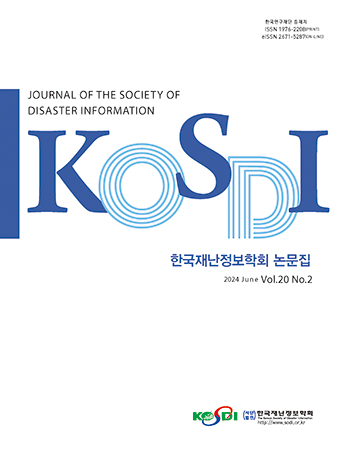Original Article
Abstract
References
Information
Purpose: The purpose of this study was to improve fire safety in Gosiwon, a residential space for the low-income class. Method: Problems appearing in the process of fire occurrence and damage were verified once again. In addition, we would like to suggest improvement measures through systematic discussions on blind spots. Results: As a result of examining the risk of cool fire, the causes of fire occurred in various ways. In addition, the possibility of radiant heat due to heat accumulation due to narrow rooms inside the Gosiwon was high. Also, it was found that the possibility of fire spread was high due to clothing and household goods. It was reconfirmed that the poor internal structure of a narrow indoor space had a significant effect on the spread of fire and the scale of damage as it tried to accommodate as many people as possible inside. Conclusion: It is necessary to complete the installation as soon as possible for Gosiwon where the simple sprinkler is not installed. For this, a stronger driving force from the government and local governments is needed. In addition, it will be necessary to discuss how to improve the spatial and structural fire vulnerabilities that appear due to the structural characteristics of the Gosiwon.
연구목적: 저소득계층의 주거공간인 고시원을 중심으로 화재안전성의 향상이라는 부분에 목적을 두었다. 연구방법: 화재 발생 및 피해 과정에서 나타나는 문제점을 다시 한 번 검증하는 한편, 사각지대에 대한 제도적인 논의를 통해 개선방안을 제시하고자 한다. 연구결과: 고시원화재의 위험성을 살펴본 결과, 객실 내부에서 발생하는 화재발생 원인은 다양하게 나타날 수 있으나 좁은 객실로 인한 열축적에 의한 복사열 가능성이 높고 의류 및 가재도구 등으로 인해 화재 확산 가능성도 상당하다는 것을 알 수 있었으며, 이는 내부에 가급적 많은 인원을 수용하려고 하다 보니 좁은 실내공간의 열악한 내부 구조가 화재 확산 및 피해 규모에 상당한 영향을 미치고 있다는 것이 재확인되었다. 결론: 간이스프링쿨러 미설치된 고시원에 대하여는 조속히 설치가 완료 될 수 있도록 정부 및 자치단체의 더욱 강력한 추진력이 필요한 반면, 고시원의 구조특성상 나타나는 공간적, 구조적 화재취약성에 대하여 어떻게 개선할 것인가에 대한 논의가 필요할 것이다.
- Choi, B-i. (2009). Study on the Institutional Problems of the State Exam Students' Residential(one-room) Buildings and their Solutions. M.S Dissertion, Graduate School of Engineering, Yonsei University, Korea.
- Kim, H-M. (2013). A Study on the Improvement of Fire Safety in Gosiwon against to the Arson Fire. M.S Dissertion, Graduate School of Environmental & Design, Gachon University, Korea.
- Kim, I-G., Chung, Y-J. (2012). "Fuman behavior during fire evacuation in Gosiwon." Fire Science and Engineering, Vol. 2012 No. Spring season, pp. 400-403.
- Lee, H-Y., Lee J-W., Hong W-H. (2009). "A study on the fire safety according to the state of fire facilities in the study room." The Architectural Institute of Korea, Collection of thesis for Academic Presentation, Vol. 29, No. 1, pp. 621-624.
- Min, T-U. (2012). "The legal status of the Gosiwon and issues." Public Land Law Review, Vol. 58, pp. 475-496.
- Ministry of Health and Welfare (2011). National Survey on the Status of the Housing Vulnerable Class, Korea.
- Seok, H-T., Yang J-H., Kim J-H. (2009). "A study on the evacuation time according to the width of corridor, emergency exit and staircase in studyroom's fires." The Architectural Institute of Korea, Journal of the Architectural Institute of Korea (JAIK), Vol. 25, No. 4, pp. 287-294.
- 「SPECIAL ACT ON THE SAFETY CONTROL OF PUBLICLY USED ESTABLISHMENTS」, Article 9(6).
- William D.W. (2002). Estimating Temperature in Compartment Fires. KFPA-SFPE Handbook, National Institute for Standards and Technology, Chap.3-6, pp.3.171-3.188.
- Publisher :The Korean Society of Disaster Information
- Publisher(Ko) :한국재난정보학회
- Journal Title :Journal of the Society of Disaster Information
- Journal Title(Ko) :한국재난정보학회논문집
- Volume : 17
- No :4
- Pages :882-889
- DOI :https://doi.org/10.15683/kosdi.2021.12.31.882




 Journal of the Society of Disaster Information
Journal of the Society of Disaster Information







